Health Information
Dental hygiene is very important to your overall health
Bad Breath
Dental malodor or halitosis is a condition that affects 40 million people in North America.
There are two types of this condition that are recognized:
Transient malodor
Transient malador is essentially caused by foods, tobacco, alcohol and medications and usually last no more than 72 hours. Mouthwashes, breath mints and chewing gum can easily mask it.
Chronic malodor
Chornic malodor may be caused by the following:
- Mouth and tongue.
- Nose and sinuses.
- Lungs.
- Systemic disease.
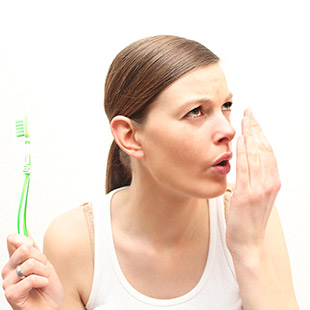
Gum disease is a major culprit in the case of bad breath and our hygienist will monitor the progress of any periodontal disease. Treatment should be followed in order to reduce the bacterial count in the mouth. Proper oral hygiene techniques are essential in brining bad breath under control.
We are all aware that the spaces between the teeth harbor a large number of odor causing bacteria and proper flossing is needed to keep these under control. What is often overlooked s the rough area on the surface of the tongue, which must be brushed to remove any food particles. A tongue scraper can be very effective in cleansing the back of the tongue. These are not commonly found on the pharmacy shelves but ask your pharmacist to special order them in for you.
Xerostomia or dry mouth is also a condition that can, not only cause bad breath but also cause gum disease and tooth decay due to reduced saliva flow.
Bonding
Dental bonding is a technique that is used extensively in the dental office. It establishes a superior union between the natural tooth structure and the artificial filling material. The end result is not only esthetically pleasing but preserves more of the underlying tooth.
Prior to bonding, the only means by which filling materials or artificial teeth could adhere to natural teeth was by using strong cement, drilling pins into the tooth structure or cutting retentive grooves into the tooth in order to lock in the filling material. By contrast, bonding is a process by which a tooth colored filling material adheres to the tooth structure forming a strong and permanent bond and usually requires no tooth preparation or local anesthetic.
The process of bonding is a powerful tool in the dental arsenal and has revolutionized many aspect of dentistry. The technique is widely used to place composite fillings, attach veneers, porcelain crowns and inlays, and also as a cost effective means of building up broken and chipped teeth.
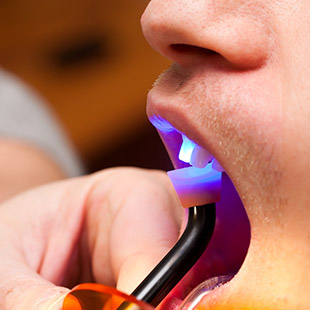
Bonding process
This technical process consists of four steps:
- A mild form of acid is applied to etch the outer surface of the tooth creating a rough area.
- Bonding agent is spread over the area and forms a strong bond with the tooth surface.
- The tooth colored resin is placed over the bonding. As the soft resin adheres to the bonding, it is molded into the required shape.
- A light which falls under the visible blue light spectrum is placed on the material to harden it.
Bruxism
Bruxism or “grinding” of the teeth is a persistent and unconscious reflex often occurring during sleep. It usually goes undetected until a family member calls attention to the grinding sound, or a dentist noticed the wear on the teeth.
Misaligned teeth, abnormal occlusion (the way the upper and lower teeth fit together), TMJ dysfunction, broke and painful teeth can all be associated with grinding. There is also psychological aspect to this condition and many agree that stress is a major contributing factor.
Treatment usually takes a multifaceted approach. Counseling and psychotherapy are effective in reducing the stress factor, while relaxing techniques and massage can help alleviate some of the pain. Muscle relaxants will help ease the tension of sore muscles.
A custom made splint is fabricated from accurate impressions of the teeth. This is worn fitted either on the lower or the upper jaw and not only protects the teeth from grinding, but also opens the bite slightly relieving the pressure on the TMJ.
Alcohol, sugar and caffeine should be avoided at least 4 hours before bedtime.

Effects of bruxism
Whatever the cause, it is known that bruxism can have detrimental effects:
- Wearing down and chipping of the enamel.
- Headaches and sore neck muscles.
- TMJ. Bruxism puts a lot of stress on the joints.
- Sleep. It is the third most common sleep disorder after sleep talking and snoring. Lack of sleep can leave you feeling tired and irritable.
- Gums. The teeth can become loose and sensitive.
- Smile. Grinding leaves unattractive flat, unnatural looking teeth.
Dental Phobia
More that 50% of the population does not visit a dentist and 10% of these avoid an office visit because fear of dental procedures.
The effects of avoiding dental care can be devastating not only to your physical well being but also to your social life and work environment. Strong healthy decay free teeth contribute to a happy healthy life style.
Avoiding dental treatment can have serious ramifications. Decayed and broken teeth decrease the ability to properly chew and digest food. Untreated gum disease can result in bad breath, tooth loss and an unaesthetic appearance, which can ultimately affect your self-confidence.
Dental fear can often be traced to adverse childhood experienced in the dental office. This anxiety is often carried to subsequent dental visits resulting in avoidance of dental treatment all together.
A visit to our office for an informal char regarding your fears and concerns can be the start of a long standing relationship based on trust and confidence.

Common signs of dental phobia
- Avoidance of treatment even with extreme pain.
- Frequently cancelling or postponing appointments.
- Sweaty palms and the feeling of helplessness.
Wisdom Teeth
Wisdom teeth are so called because they appear in the mouth between the ages of 17-25 years when a person has matured. They are the very last teeth in the mouth to erupt and due to the lack of space in the jaw can become lodged or “impacted” against the tooth in front.
This can be problematic and the offending tooth may have to be removed for the following reasons:
Decay
Plaque can easily gather in the inaccessible area between the teeth leading to tooth decay.
Pericoronitis
This is a painful condition caused by an infection in the gum surrounding the erupting tooth.
Peridontal disease
Due to difficulty in brushing and flossing around the third molar, food and plaque accumulate in this area. This can lead to gum disease, which can eventually cause the loss of not only the wisdom, but also the adjacent tooth.
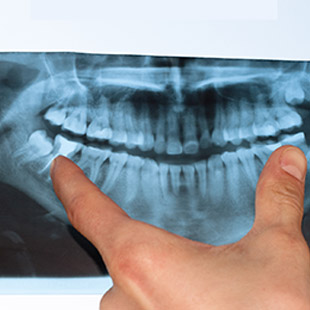
Orthodontics
It is recommended that wisdom teeth be removed after orthodontic treatment, in order to prevent further shifting of the teeth due to pressure.
Cyst
The retention of wisdom teeth can sometimes lead to cyst formation. Although the condition is uncommon it should be monitored by means of regular X-rays.
As with any surgery, it is important to fully understand the complications that may arise. While bleeding is controlled prior to you leaving the office you must continue to clamp down tightly on the packing in order to apply pressure on the area. Bruising can occur and usually appears after 24 hours. Some patients may experience swelling especially after lower wisdom teeth removal. In rare instances there may be some numbness of the lower lip and the tongue due to bruising of the nerve that supplies the sensation to these areas.
Generally the easier it is to remove wisdom teeth the lesser the complications. Overall general health and habits such as smoking and excessive alcohol consumption can also have an impact on the healing of an extraction site.
New Dentures
Be patient, it may take time to get used to wearing dentures. Some people adapt more quickly and learn to control their dentures in a shorter period of time. Having good ridges and boy support to seat the dentures can be a bonus.
Here are some tips to help you:
- Share your concerns with the professionals who fabricated your new dentures. Phone the office and come in for a consultation. Do not share your anxieties with friends. Every individual case is different and needs to be handled accordingly.
- Wear the dentures for at least 24 hours prior to coming in. This will allow us to spot the pressure sites and adjust the dentures.
- Eat soft foods at first and chew on both sides of your mouth. Cut your food up into small bites.
- Keep your dentures clean by using a proper denture brush and denture cleaners.
- Refrain from adjusting the dentures yourself.
Considerable care has been taken in custom fabricating your new dentures, and once comfortably settled in, they will provide you with many years of service.
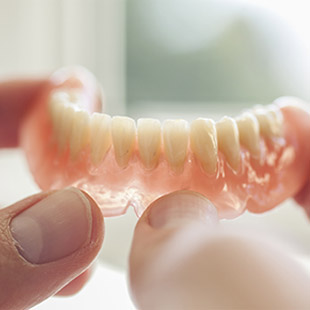
First time denture wearer?
Three obstacles you’ll have to overcome:
- Excessive saliva, for the first 24 hours. The mouth reacts to any foreign body as it would to food by salivation as the first step to digestion. Once the body gets used to having the prosthesis the salivation gradually decreases.
- Speech. The denture covers the palate, so the tongue has to adapt to the extra thickness.
- Eating. The teeth on a denture are all attached to one base and chewing on one side can cause the denture to tip.
Diabetes
Diabetes is a serious medial condition that requires good medical management. Patients with diabetes are more susceptible to gum disease and infections.
These infections take longer to heal and in severe cases can cause the teeth to loosen and fall out. The most crucial factor in minimizing the damage caused to gum tissue is the control of blood sugar levels.
It is important to inform us of your medical condition in order for us to take the proper precautions. Dental appointments are preferably scheduled in the morning, as this is a time of high glucose and low insulin activity. Make sure you have taken your medication and that you have had a light snack. If you feel the symptoms of an insulin reaction during the appointment let us know immediately.
Dental treatment is better managed with local anesthetics as general anesthetics can produce hyperglycemia.
Diabetics should have dental check ups every 6 months and thorough cleanings every 3-6 months depending n the health of their gums. Good home care including brushing and flossing is essential. We may recommend an antibacterial mouthwash to destroy the bacteria causing gum disease thereby limiting the damage to the gum tissues.
With appropriate care and a good understanding of the disease diabetics can lead a normal healthy life.

Some oral complications of uncontrolled diabetes:
- Dry mouth.
- Reoccurring infections.
- Delayed healing.
- Increased susceptibility to gum disease.
- Burning sensation in the mouth.
- Tingling numbness or pain in the mouth.
TMJ Disorder
The mandible is a horseshoe shaped bone that is joined to the base of the skull by two joints. Each joint is like a ball fitting into a socket; with the ball portions being on the lower jaw while the two sockets are on the skull. A cushion or disc lies between the “ball and socket” and this helps the joint to glide smoothly. These complicated joint that connects the lower jaw to the skull are called the temporomandibular joints. The TMJ are unique in that they work in tandem giving the mandible the wide variety of movements necessary for the functions of chewing.
TMJ disorder is not fully understood however; there are a number of known factors that contribute to this disorder.
Some of the symptoms include persistent headaches, earaches, popping or crackling of the joint and a limited mouth opening.
For the treatments of acute symptoms, a soft diet, hot compresses or a cold pack with muscles relaxants and painkillers is recommended. Orthodontics may be required to correct a malocclusion. In the case of bruxism an acrylic splint is worn to relieve the pressure on the joint. In extreme cases surgery is indicated as a last resort.

Factors that contribute to TMJ Disorder
- An incorrect bite if left untreated (see Orthodontics)
- Sudden injury during sport (see Mouth Guards)
- A motor vehicle injury
- Arthritis
- Clenching or grinding the teeth (see Buxism)
Dry Mouth
Dry mouth is a condition caused by the lack of saliva necessary to moisten the mouth.
The treatment for dry mouth can vary depending on the cause. It is important to see the dentist or physician for examination and diagnosis. Medication induced dry mouth can be treated by changing the medication or adjusting the dose, or if cause by other reasons the use of saliva substitutes may be recommended along with frequent sipping of water.
It is also suggested to avoid the following, which aggravate dry mouth:
- Beverage with caffeine such as tea, coffee and soft drinks.
- Tobacco and alcohol use.
- Spicy or salty foods.
It is crucial for dry mouth sufferers to maintain good oral hygiene to protect against tooth decay. Regular brushing, flossing, fluoride rinses and dental checkups with allow these patients to maintain an healthy mouth and teeth.

Symptoms of drymouth:
- Dryness and burning of mouth and throat
- Cracked lips.
- Difficulty chewing, swallowing and speaking.
- Frequent thirst.
- Increased tooth decay.
- Causes.
- Systemic diseases: AIDS, Diabetes and Parkinson disease.
- Radiation to the head and neck: resulting in damaged salivary glands
- Medications
Pregnancy
One of the most common side effects of pregnancy on dental heath is pregnancy gingivitis. This is inflammation and bleeding of the gums caused by elevated levels of pregnancy hormones. It is crucial to maintain good oral hygiene by brushing and flossing even though the gums are swollen and sore.
Pregnancy gingivitis is generally most severe in the latter part of the pregnancy and diminishes during the ninth month. Tumors can sometimes develop from sore gums, they are usually harmless and require no intervention unless they are uncomfortable or inhibit speech.
Research supports a ban on X-rays during pregnancy except in emergencies, when they may be necessary to diagnose infections, which can spread and complicate a pregnancy if left untreated. Antibiotics such as tetracycline, and painkillers such as Aspirin, Ibuprofen should be avoided although Penicillin, Amoxicillin and Tylenol may be used after consultation with the attending obstetrician.
In general, elective dental treatment should be postponed until after childbirth although necessary treatments such as broken teeth and fillings or cavities are best treated during the second trimester.
When planning a family, pre-pregnancy checkups and X-rays are essential, as any treatment diagnosed can then be performed prior to the onset of pregnancy. This will also provide a foundation for maintenance care during pregnancy.

Gum disease
Periodontal disease affects over 70% of the North American adult population. At its onset it causes the gums to become tender and bleed slightly. The final stages of this disease can cause tooth loss.
Gum disease is not only devastating to the oral health but researchers have linked it to various systematic diseases including heart disease, stroke, and pregnancy problems. It also poses a serious threat to people whose health is compromised by diabetes, respiratory disease and osteoporosis.
Most common forms of periodontal disease are as follows:
Gingivitis
This is the initial stage when the gums are tender and bleed easily. It is easily controlled with proper home and professional care. If untreated however it can lead to more serious complications.
Periodontitis
The gums separate from the teeth forming “pockets”. It is very difficult to properly clean these “pockets” as they are below the gum line and bacterial toxins start to break down the bone and connective tissues that support the tooth. If untreated this can lead to the eventual loss of the tooth.
The main culprit in periodontal disease is plaque formation due to improper oral hygiene (see brushing and flossing), however the following factors can contribute to the disease:
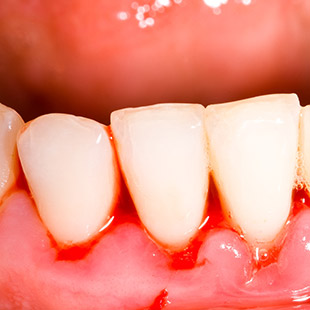
Factors that contribute to gum disease:
- Smoking
- Poor Nutrition
- Stress
- Hormonal changes during puberty and pregnancy.
- Medications with side effects that can affect the gums
- Diabetes
- Genetics
Unfortunately there are very few symptoms at the initial phase of periodontal disease, and the dentist or hygienist usually diagnose early onset in the dental office. Symptoms include bad breath, red, bleeding gums with loose and sensitive teeth.
Treatment involves a non-surgical and a surgical approach. If the pockets are accessible to the dental instrument, the deep deposits are removed by scaling the roots of the teeth. The rough roots are now planed to their original smoothness. If the pockets are deep and inaccessible a surgical flap approach is taken. Here the gum tissues are released facilitating the removal of all the sub gingival deposits. Once clean, the gums are sutured snugly back in place.
Incase of severe gum recessions a tissue graft may be recommended. A small piece of tissue is taken from the plate and placed at the recession site to make up for the gingival that is lost. Bone grafts are also indicated in areas where there is severe bone loss.
Oral Lesions
The vast majority of oral lesions are harmless. A small number of these, however are dangerous and if untreated may progress to oral cancer. The key to the treatment of any form of cancer is early decision with prompt and aggressive management of the disease.
Research has yet to identify the cause of oral cancer and although we know that genetics has a major role, there are certain contributing factors that play a large part in the onset of this disease. Oral cancer is related to smoking and alcohol consumption; consequently the use of tobacco and consumption of large amounts of alcohol can increase the chances of cancer.
Another key factor is the presence of rough or jagged fillings and broken teeth, which cause constant irritation to the surrounding tongue, lip and cheek areas leading to cancerous sores.
Cancer lesions in the early stages are small, flat and often found in areas that are not visible. A cancer screening is performed at our office at regular intervals. A self-examination between visits to check for any early signs is advisable. A screening consists of a neck and a head exam, and checking the lips, gums, cheeks, palate and tongue.
The teeth should be maintained with no sharp or rough edges to irritate the surrounding tissues and any jagged retained roots be removed. Dentures should fit properly and no sore spots should be tolerated.
Detection is usually by means of a biopsy, which involves the removal of the lesion along with some surrounding tissues to be examined microscopically.
Treatment for oral cancer involves surgical removal, radiation therapy, chemotherapy or a combination.

Some of the signs and symptoms of oral cancer include the following:
- A hard lump in the soft tissues of the mouth.
- Numbness in the lips, tongue or cheeks.
- Tightness in the throat with difficulty in swallowing.
- An ulcer that does not heal.
Tobacco
Most of us are aware of the connection between heart and lung diseases and tobacco products such as cigarettes, cigars, pies and smokeless tobacco. Lesser know are the adverse effects of these products on oral health. Among some of the associated problems are bad breath, stained teeth and tongue, and diminished taste sensation. More serious problems include gum disease and oral cancer.
Smoking is a significant factor in the development of gum disease. Smokers are more susceptible to tartar (hard deposit) build up on the teeth. This predisposes the gum tissue to infection and the formation of pockets around the teeth. Bacteria residing in these pockets destroy tissue and bone resulting in gum recession, tooth exposure and infection and ultimately tooth loss.
Chemicals in cigarettes and smokeless tobacco damage the oral tissue resulting in oral cancer. The most typical locations of this disease include the sides and undersurface of the tongue, floor of the mouth, and sides of the lips and cheeks (see oral lesions).
Early detection of oral cancer vastly improves survival rates while early detection of gum disease can prevent tooth loss. This emphasizes on the importance of regular examination as an important tool in the diagnosis and treatment of these devastating diseases.

Oral Piercings
In recent years piercing or the lips, tongue or cheeks has become popular with the younger generation. There are serious health risks involved that should be taken into consideration.
Keeping the pierced area clean is essential in preventing any infections. The mouth is a harbor for many bacteria and the puncturing of any part of the oral cavity can introduce these bacteria into the blood stream and the vital organs of the body.
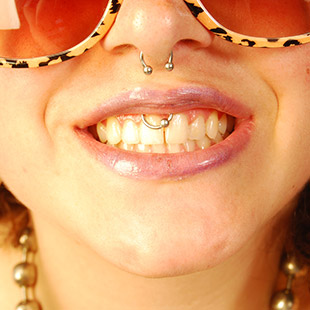
Health risks associated with piercings to note:
- Infections can be bacterial and may involve the surrounding tissues. A severe swelling of the tongue could cause a blocking of the airway. A viral infection such as hepatitis or HIV can also be transmitted.
- Bleeding can be a complication as the mouth is a very vascular region.
- Inhaling a piece of loose jewelry into the lungs can lead to major surgery.
- Fracture of teeth coming into contact with a hard piece of jewelry can easily lead to expensive dental treatment.
- Drooling, nerve damage, and speech impairments.
Sensitive Teeth
Tooth sensitivity is a painful reaction following exposure of the teeth to hot, cold, sweet or sour stimuli.
Causes of sensitive teeth:
- Tooth decay exposing the tooth to bacteria
- Brushing too hard causing abrasion of the enamel and exposure of the more sensitive dentin under layer.
- Gum recession.
- Grinding teeth.
- Poor oral hygiene.

Treatment For Sensitive Teeth
- Filling decayed teeth
- Brushing with a soft toothbrush
- Using fluoridated toothpaste for sensitive teeth which can be directly spread over the affected areas and left on for 15 minutes followed by rinsing
- Using a fluoride rinse
- Wearing a night guard to alleviate symptoms of tooth grinding
- Good oral hygiene to reduce plaque build up and tissue irritation
- Regular dental check ups
Post Extractions
Surgical procedures of any kind are traumatic for the body, and adequate rest from strenuous physical activity is necessary to allow the natural defence mechanism of the body to help heal the surgical site.
Slight swelling, pain and bleeding are to be expected after an extraction or any surgery performed in the mouth and taking the following precautions will help minimize these symptoms:
Bleeding
Firm stead pressure should be applied to the site. Avoid rinsing or spitting, as this will disturb the clot. Use a moistened tea bag to help control any oozing.
Diet
Follow a soft diet; drink lot of water and fresh juices.
Oral Hygiene
Brush normally after 12 hours but use a cotton swab around the surgical site to gently clean around the teeth. Do not disturb the clot or the wound.
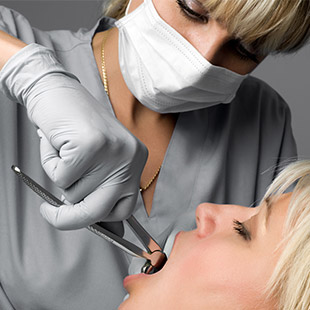
Limited Mouth Opening
This is the response of the body to immobilize the traumatized area and should resolve on its own.
Medications
Follow the direction on the medications. Make sure you complete the antibiotic course and if pain medication has been prescribed avoid driving a car or using any machinery.
Pain
Use over the counter painkillers but avoid aspirin products as they may interfere with the clotting mechanism causing bleeding.
Smoking
Do not smoke for at least 24 hours as this may cause the clot to break down and hinder the healing process.
Sutures
Sutures may have been placed to secure the wound. They are absorbable which don’t need to be removed and will remain intact for 7-10 days or they are non-absorbable and these are usually removed a week later.
Swelling
Swelling and bruising is to be expected and application of ice to the outside of the face for the first 24 hours will help in controlling this. Heat should be applied after 24 hours as this increases the blood circulation; which will reduce any swelling or bruising.
Should you have any concerns or questions please phone our office immediately.
